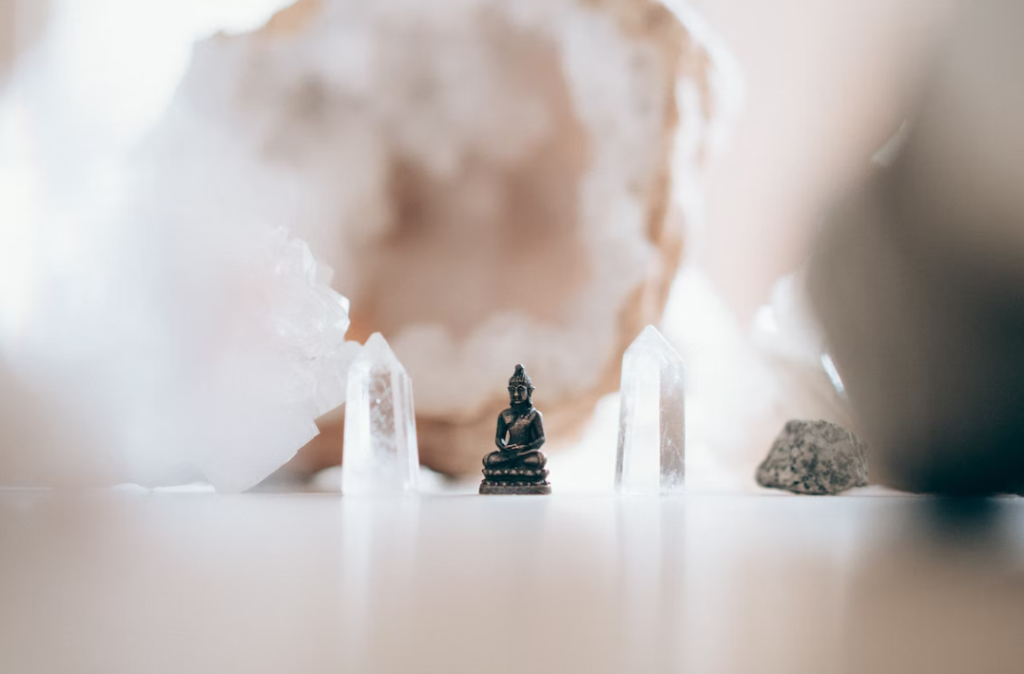How Mantra Meditation Works
Discover how to use a mantra in meditation to focus the mind, collect distracting energies, and bring spiritual insights forward.

Selfpause Affirmation App
Download the app to get 1,000’s of affirmation meditations and everything you need to write, record and listen to your own.
If you’re curious how mantra meditation works, you’ve come to the right place. The use of a mantra in meditation is a powerful way to focus the mind, collect distracting energies, and bring spiritual insights forward. It is similar to listening to great music: it transforms the listener and lifts the spirit.
Harmonic vibration

Mantras are a form of meditation that combines sound, movement and meditation. They can calm the mind, lower blood pressure, relieve unnecessary anxieties and change the focus of your life. They can also release a transcendental vibration from the spiritual world. Scientists have proven the healing and emotional benefits of mantras.
The Om Mani Padme Hum mantra is one example of a mantra used for meditation. It is a six-syllable mantra from Tibetan Buddhism, associated with the bodhisattva Avalokitesvara. This mantra generates mystical vibrations that interact with the human body at a biochemical level. In addition, it has been proven to enhance cognitive effects in organisms without auditory apparatus.
Mantras can help people improve their hearing, communication, and behavior. Practicing mantras can help you overcome any obstacles you encounter. They help you hear more clearly and respond more consciously. Moreover, they help you develop your concentration skills. You can easily learn to perform mantras by repeating them over again.
The AUM mantra can help people bridge the gap between their conscious and subconscious minds. It also calms fluctuations in the mind. Chanting the AUM mantra three times will do the trick. By doing this, you’ll be able to focus your attention on the mantra and your mind.
Alpha brain waves

Alpha brain waves are associated with relaxed awareness, creative thinking, peak performance, imagination, and intuition. This state helps people concentrate and gives them the edge when confronted with a task. It also boosts problem-solving abilities. In addition, it can increase athletic performance. Mantra meditation, in particular, can help you achieve this state.
Alpha brain waves are produced when the left and right sides of the brain work together in a balanced manner, and are associated with a calm, peaceful mind. These waves have been associated with learning, creativity, and even super-learning, and synchronizing both hemispheres of the brain can improve your intellectual functioning, as well as your emotional and physical well-being.
Alpha brain waves are the most useful when it comes to work performance. They can help you meet deadlines and remain relaxed. However, if you do not have access to this state of consciousness, it is possible to increase your levels with certain techniques. Here are a few tips on how to boost your alpha brain waves:
Alpha waves oscillate between theta and beta waves, and they help you enter the flow state. This calm state allows you to perform deep work with less effort, and it helps you absorb new information easily. This is a great way to increase your creativity and productivity. By practicing mindfulness and meditation, you can stay in the alpha state longer.
Sacred utterances

The practice of mantra meditation involves chanting sacred utterances or words. Some are spoken aloud, while others are inaudible and are recited silently. In either case, the words used are the same as those used in prayer. These are known as mantras, and they are considered to be the silent instruments of meditation. There are six basic types of mantras, called shadanga. The first three deal with defining characteristics, while the fourth deals with expressing intentions and requests.
In the Hindu tradition, Sacred utterances are repeated, sometimes hundreds of thousands of times per day. These chants invoke different deities, such as Lord Shiva, or individual principles such as Brahma and Vishnu. The most basic mantras, however, focus on the One underlying reality.
In Hinduism and Buddhism, mantras are considered sacred utterances. They are often used in religious rites and are said to have magical effects. In addition to their meditative properties, they are also used for protection. For this reason, a guru is often assigned the task of teaching a certain mantra.
The practice of mantra meditation can be quite effective in overcoming suffering. The purpose of chanting a mantra is to connect to your inner self and experience divine power. You can do this by chanting the name of a deity or calling the name of a holy deity with a pure heart.
Visualizations

Visualization is a method of meditation that focuses your mind on specific things that you want to achieve. Similar to guided imagery, visualization is a technique that lets you picture specific outcomes in your mind. It can be used to complement regular meditation and direct a relaxed mind toward a desired outcome.
Visualization is an essential part of meditation, and should be done with a focused mind and body. Start by setting aside a quiet place where you can concentrate. You may want to place your cell phone on ‘do not disturb’ mode before you begin. You may also want to focus on an object to help you visualize. Choosing an object that you can focus on will keep your mind calm and alert throughout the visualization process. If you are new to visualization, keep practicing until you find it easier.
Visualizations during mantra meditation can be powerful and empowering. These visualizations can help you create your goals and manifest them in your life. You may find it beneficial to visualize your goals when facing a stressful work situation. These visualizations can help you release pressure and calm your nerves. They can also help you manifest your desires.
Once you begin meditating with your chosen mantra, you can choose an object to focus on. Start by visualizing a peaceful place or an ideal outcome. Then, take deep breaths to relax your body. Continue the visualization process even after you finish your meditation.
Rituals

Mantra meditation is an esoteric form of meditation that focuses on the power of sound to transform consciousness. The practice involves repeating a mantra to focus your attention. Mantra teachers believe that every sound has a specific quality, and different types of mantras produce different states of consciousness. Mantras also have a connection to breathing, specific visualizations, and the chakras.
Rituals in mantra meditation include the Shanti Mantra, which is said to calm obstacles and bring peace to your soul, body, and mind. Once performed, the mantra will help you experience inner peace and harmony forever. During mantra recitations, you repeat syllables from the Vedic Sanskrit language. These syllables have spiritual vibrations, which cause biochemical changes and other effects that help you transform your physical body.
During mantra meditation, it’s important to notice when your attention wanders. When this happens, gently return your attention to the mantra. In addition, try picturing the mantra as your dinner partner, who is also meditating with you. Don’t join in on other people’s conversations, but simply listen to the mantra.
Mantras are a part of many cultures and religions. In Hinduism, for example, they are used in religious ceremonies. They are also used in many New Age religions. Mantras can be used to attract wealth, ward off danger, or remove enemies.
Benefits

Mantra meditation can help you overcome a variety of problems. As you practice, your concentration will increase. You can adjust your mantra to your current state of mind or to your desired goal of meditation. The best part is that your mantra doesn’t have to stay the same all the time. You can switch it up to focus on a different subject each time you meditate. While you may not experience immediate results, you should keep practicing to get the most out of mantra meditation.
Another benefit of mantra meditation is that it helps you cope with negative thoughts and emotions. It also provides a focal point for your meditation sessions, which helps you overcome distractions and negative energy. Mantra meditation can also have a positive effect on your aura and personality. When used properly, mantra meditation can help you feel calm and centered and can even help you sleep better.
Another benefit of mantra meditation is that it helps you focus on a single word or phrase. The repetition helps you achieve a deeper meditative state, which helps release trapped energy. Additionally, using a word that is meaningful to you can reinforce the feeling of happiness and joy that you experience when you practice meditation.
Mantras are often written in the native language of a spiritual group. Because of this, they have special potency when spoken in the original language. If you’re unsure of the exact meaning of a mantra, you can learn more about it by visiting a local yoga studio or meditation center.
Our Top FAQ's
A mantra is a word or phrase that is repeated during meditation as a way to focus the mind and bring about a state of relaxation and calmness. The repetition of the mantra can help to quiet the mind and allow the meditator to let go of thoughts and distractions. Mantra meditation is an effective tool for cultivating inner peace and clarity.
There are many different mantras that can be used for meditation, and the best one for you may depend on your personal preferences and goals. Some people choose a mantra based on its meaning or significance to them, while others may use a mantra that has been recommended by a teacher or spiritual tradition. Some popular mantras used in meditation include “Om,” “peace,” “love,” and “calm.”
To use a mantra in meditation, begin by finding a comfortable and quiet place to sit or lie down. Take a few deep breaths and allow your body to relax. Then, begin repeating the mantra in your mind, either out loud or silently to yourself. It can be helpful to set a specific number of repetitions or a specific time for your meditation, or you can simply repeat the mantra for as long as you feel comfortable. As you repeat the mantra, try to let go of any thoughts or distractions that arise and focus solely on the repetition of the mantra.
Mantra meditation can have a number of potential benefits, including reducing stress and anxiety, improving focus and concentration, and promoting a sense of inner peace and well-being. Some research suggests that mantra meditation may also have physical health benefits, such as reducing blood pressure and improving sleep quality.
Mantra meditation is generally considered safe and can be practiced by people of all ages and backgrounds. However, it is important to remember that meditation should not be used as a substitute for medical treatment or therapy. If you have any concerns about starting a meditation practice or using a mantra in meditation, it is always a good idea to consult with a healthcare professional or a qualified meditation teacher.
